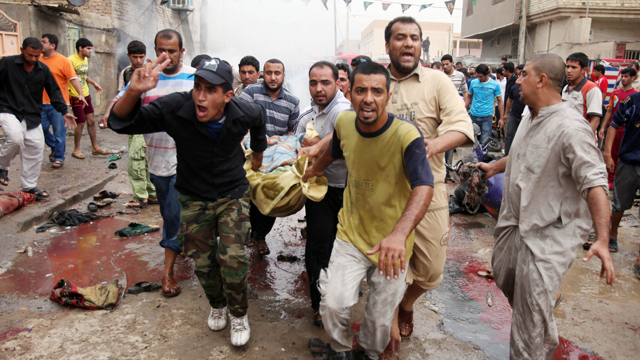
Men carry a victim injured in one of a series of parked car bombs in the Shiite stronghold of Sadr City in Baghdad, Iraq, Friday, April 23, 2010. (AP Photo/Karim Kadim)
While Americans tend to see their country’s involvement in Iraq as two discrete conflicts – “Operation Desert Storm” in 1991, and the 2003 Iraq war — most Iraqis view it as one protracted campaign.They have good reason. We’ve been waging hot and cold war on Iraq for almost a quarter of a century.
As American boots once again hit the ground in Baghdad — and as the Obama administration mulls other “options” — it’s important to remember that after 24 years of military, political and economic intervention in Iraq’s affairs we’ve caused a lot of death and hardship, but accomplished none of our stated goals. The region has never been less stable, there is still an abundance of innocent blood being shed, oil prices remain high and Iraqis enjoy neither democracy nor prosperity. Many suffer from a lack of basic public services like running water and electricity.
Saddam Hussein’s government was a corrupt military dictatorship that brutally repressed dissent, but before the first Gulf War, Iraq was a functional country that had adequate public services and the security that allowed Iraqis to walk through their streets in relative safely.
US intelligence agencies were actively assisting Saddam Hussein in his conflict against Iran throughout the 1980s, and continued to do so as late as 1988. We knew who we were dealing with at the time. As Shane Harris and Matthew Aid reported for Foreign Policy last year, “The Iraqis used mustard gas and sarin [nerve agent] prior to four major offensives in early 1988 that relied on U.S. satellite imagery, maps, and other intelligence.”
These attacks helped to tilt the war in Iraq’s favor and bring Iran to the negotiating table, and they ensured that the Reagan administration’s long-standing policy of securing an Iraqi victory would succeed. But they were also the last in a series of chemical strikes stretching back several years that the Reagan administration knew about and didn’t disclose.
Following the Iran-Iraq war, Hussein’s cruelty became a political liability, and Iraq’s invasion of Kuwait triggered the first of two major US-led wars against the country.
Like the 2003 war, the 1991 conflict was sold to the American people based on a series of what later proved to be falsehoods.
And contrary to the belief of many Americans who were first introduced to Iraq with CNN’s breathless coverage of “precision” bombings that supposedly minimized civilian casualties, the fighting was anything but clean.
The war began with a series of massive airstrikes in January of 1991, followed by a ground invasion in February.
The Iraqis offered only disorganized and ragged opposition to the American invasion, in February of 1991, and the much feared ground war quickly turned into a bloody rout, with many of the retreating Iraqi units, including the elite Republican Guard, being pounded by American aircraft, artillery, and tanks as they fled north in panic along a six-lane road from Kuwait City to Basra, the major military stronghold in southern Iraq. The road became littered with blackened tanks, trucks, and bodies; the news media called it the “highway of death.”
While the “highway of death” gained international media attention, there were no reporters on another road out of Kuwait where a massive ground attack two days after the US had officially declared a ceasefire killed “not only Iraqi soldiers but civilians and children as well,” according to Hersh. He added: “Many of the dead were buried soon after the engagement, and no accurate count of the victims could be made.”
[The] offensive… was not so much a counterattack provoked by enemy fire as a systematic destruction of Iraqis who were generally fulfilling the requirements of the retreat; most of the Iraqi tanks travelled from the battlefield with their cannons reversed and secured, in a position known as travel-lock. According to these witnesses, the 24th [Infantry] faced little determined Iraqi resistance at any point during the war or its aftermath; they also said that [24th Infantry commander Barry] McCaffrey and other senior officers exaggerated the extent of Iraqi resistance throughout the war.
Hersh also reported allegations that Bradley Fighting Vehicles from the 24th Infantry had fired on more than 350 “captured and disarmed Iraqi soldiers, including Iraqi wounded who had been evacuated from a clearly marked hospital bus,” and “it was not known how many of the Iraqis survived, if any.”
There was similar destruction elsewhere. In a report to the UN Security Council following the withdrawal of US ground forces in 1991, then-Secretary General Javier Pérez de Cuéllar wrote that nothing his team “had seen or read quite prepared us for the particular form of devastation which has now befallen the country.”
The recent conflict has wrought near-apocalyptic results upon the economic infrastructure of what had been, until January 1991, a rather highly urbanized and mechanized society. Now, most means of modern life support have been destroyed or rendered tenuous. Iraq has, for some time to come, been relegated to a pre-industrial age, but with all the disadvantages of post-industrial dependency on [modern technology].
Iraq would never fully recover, in large part due to crippling sanctions imposed by the UN at the request of the US and British.
For the first five years after the 1991 conflict ended, Iraq was barred from exporting oil – its lifeblood – and couldn’t import food or life-saving medicines.
In 1995, The New York Times reported that “as many as 576,000 Iraqi children may have died since the end of the Persian Gulf war because of economic sanctions imposed by the Security Council, according to two scientists who surveyed the country for the Food and Agriculture Organization.”
Researchers found that mortality rates for children under five had tripled during the war and its immediate aftermath. By [1995], the rate had increased fivefold.
Deaths related to diarrheal diseases have tripled in an increasingly unhealthy environment… Water and sanitation systems have deteriorated, hospitals are functioning at 40 percent of capacity, food prices are high and many people are living on Government rations that provide only 1,000 calories a day.
A report by a coalition of human rights groups concluded, “Civilian suffering in Iraq is not an unexpected collateral effect, but a predictable result of the sanctions policy.” In 1996, 60 Minutes host Leslie Stahl asked then-Secretary of State Madeleine Albright, “We have heard that a half-million children have died. That’s more children than died in Hiroshima. Is the price worth it?” Albright responded, “I think this is a very hard choice, but the price — we think the price is worth it.”
And then there was the bombing. Lots of bombing. John Pilger reported for The Independent that “there is bombing almost every day: it is the longest Anglo-American aerial campaign since the Second World War; yet it is mostly ignored by the British and American media.”

A girl whose mother was killed in a US military raid cries as she is consoled by a relative in front of her house in Kut, 160 kilometers (100 miles) southeast of Baghdad, Iraq, Monday, April 27, 2009. (AP Photo/Khalid Mohammed)
During the 12-year period when American boots weren’t on the ground in Iraq, the US and the UK — and, in the beginning, France — flew 200,000 combat sorties over Iraq, frequently attacking military installations and shooting down four Iraqi aircraft (as well as two US Army Blackhawk helicopters carrying 26 coalition troops in a “friendly fire” incident in 1994).
The US and UK claimed that the UN Security Council had authorized the two “no-fly zones” over Northern and Southern Iraq with Resolution 688. But as John Pilger later reported for The Independent, “There is no reference to no-fly zones in Security Council resolutions, which suggests they have no basis in international law.”
I went to Paris and asked Dr. Boutros Boutros-Ghali, the Secretary-General of the UN in 1992, when the resolution was passed. “The issue of no fly zones was not raised and therefore not debated: not a word,” he said. “They offer no legitimacy to countries sending their aircraft to attack Iraq.” “Does that mean they are illegal?” I asked. “They are illegal,” he replied.
The almost daily bombings, which went largely unreported by the Western media, were punctuated by five intense air campaigns of up to 300 aircraft. Four were ordered by Bill Clinton in 1993, 1996, 1998 and 1999; another was launched by George W. Bush just 26 days after he took office.
The strikes were meant to punish the Iraqi government for various infractions, but the 1998 campaign was launched just as the House began debating the prospect of impeaching Clinton over the Monica Lewinsky affair, and critics at the time suggested that it was timed to distract the public from his domestic problems.
The 1993 strikes were in retaliation for an alleged Iraqi plot to assassinate George HW Bush during a trip to Kuwait, but as Michael Isikoff reported for Newsweek in 2008, no evidence was ever uncovered that such a plot existed. According to Isikoff, Amnesty International suspected that the person who claimed that he had been instructed by an Iraqi intelligence agent to kill the former president may have been tortured by Kuwaiti authorities.
The bombings intensified in the lead up to the 2003 invasion. The Bush administration then ignored international opposition and launch a second, full-scale ground war against Iraq. At the time, Saddam Hussein’s military was well contained within the two no-fly zones, and as the UN’s chief weapons inspector Hans Blix would later attest, the Iraqi government was in compliance with Security Council resolutions at the time and cooperating with weapons inspectors.
Most Americans don’t grasp how bloody that war was. A 2007 poll by the Associated Press found that Americans believed that fewer than 10,000 Iraq civilians had been killed in the conflict. But at the time, as John Tirman, the executive director of MIT’s Center for International Studies noted, the 2003 Iraq war had taken “hundreds of thousands of lives through direct violence and indirect causes like malnutrition and demolished health services.”
Tirman commissioned an epidemiological study that was published in the British medical journal The Lancet. Of that study, he wrote, “The most accurate method of estimating mortality–randomized, household surveys — held that between 400,000 and 650,000 ‘excess deaths’ had occurred as a consequence of the war” between 2003 and 2006. Other studies have produced estimates in the same ballpark.
For most Americans, the Iraq conflict(s) ended in 2011. But as Iraqi native Raed Jarrar recently told BillMoyers.com, “Contrary to what many people here think… the US never stopped interfering in Iraq’s business. [The US] continues to sell the Iraqi government billions of dollars worth of weapons, has training programs for Iraqis, and of course is picking and choosing who to train and who to arm in a situation that’s extremely complicated.”
Jarrar added: I don’t think many Iraqis “would disagree that the US occupation and invasion and everything that happened after it made the country much worse” than it had been under Saddam Hussein. Indeed, a 2011 Zogby poll found that only 30 percent of Iraqis believed that their country was “better off” because of the 2003 Iraq war.
The United States has been bombing Iraq off and on for almost a quarter of a century, and in the process we’ve achieved only death and destruction. Last March, before the Syrian civil war spilled over into Iraq and a decade after the US invasion, David Sessions surveyed the daily life of Iraqis for The Daily Beast, and found that they continued to face regular power outages and problems with their water supply.
But according to Sessions, the lack of security remained the most pressing issue. “There are bombs constantly,” said one Iraqi from Baghdad. “It’s all people talk about in their daily conversations. Yesterday there were eight bombs. The day before it was nine. It never stops.”
Today, 24 years after our conflict with Iraq began, what was once the most secular state in the Middle East — a country where Shia and Sunni, despite some cultural tensions, had largely lived in peace for 80 years — is being ripped apart by sectarian conflict. Even as some of the millions of Iraqis displaced during the war return home, the conflict with The Islamic State has produced over a million new refugees.
That’s the context in which we have to evaluate calls to escalate our involvement there today — especially from the people Bill Moyers described as “the very same armchair warriors in Washington who from the safety of their Beltway bunkers called for invading Baghdad” in 2003 — many of whom were also responsible for the first Gulf War and the crushing sanctions regime in between the two.


